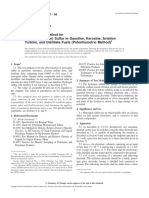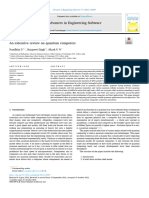0 ratings0% found this document useful (0 votes)
81 views21 Marking Scheme: Worksheet (A2) : E E E E
21 Marking Scheme: Worksheet (A2) : E E E E
Uploaded by
vinuyeCopyright:
© All Rights Reserved
Available Formats
Download as PDF, TXT or read online from Scribd
21 Marking Scheme: Worksheet (A2) : E E E E
21 Marking Scheme: Worksheet (A2) : E E E E
Uploaded by
vinuye0 ratings0% found this document useful (0 votes)
81 views3 pagesOriginal Title
M_Schemes_21
Copyright
© © All Rights Reserved
Available Formats
PDF, TXT or read online from Scribd
Share this document
Did you find this document useful?
Is this content inappropriate?
Copyright:
© All Rights Reserved
Available Formats
Download as PDF, TXT or read online from Scribd
Download as pdf or txt
0 ratings0% found this document useful (0 votes)
81 views3 pages21 Marking Scheme: Worksheet (A2) : E E E E
21 Marking Scheme: Worksheet (A2) : E E E E
Uploaded by
vinuyeCopyright:
© All Rights Reserved
Available Formats
Download as PDF, TXT or read online from Scribd
Download as pdf or txt
You are on page 1of 3
21 Marking scheme: Worksheet (A2)
1 a The atoms in a solid are arranged in a three-dimensional structure. [1]
There are strong attractive forces between the atoms. [1]
The atoms vibrate about their equilibrium positions. [1]
b The atoms in a liquid are more disordered than those in a solid. [1]
There are still attractive electrical forces between molecules but these are weaker than
those between similar atoms in a solid. [1]
The atoms in a liquid are free to move around. [1]
c The atoms in a gas move around randomly. [1]
There are virtually no forces between the molecules (except during collisions) because they
are much further apart than similar molecules in a liquid. [1]
The atoms of a gas move at high speeds (but no faster than those in a liquid at the same
temperature). [1]
2 The atoms move faster [1]
because their mean kinetic energy increases as the temperature is increased. [1]
The atoms still have a random motion. [1]
3 a The internal energy of a substance is the sum (of the random distribution) of the kinetic
and potential energies of its particles (atoms or molecules). [1]
b There is an increase in the average kinetic energy of the aluminium atoms as they vibrate
with larger amplitudes about their equilibrium positions. [1]
The potential energy remains the same because the mean separation between the atoms
does not change significantly. [1]
Hence, the internal energy increases because there is an increase in the kinetic energy of
the atoms. [1]
c As the metal melts, the mean separation between the atoms increases. [1]
Hence, the electrical potential energy of the atoms increases. [1]
There is no change in the kinetic energy of the atoms because the temperature remains
the same. [1]
The internal energy of the metal increases because there is an increase in the electrical
potential energy of the atoms. [1]
4 Change in thermal energy = mass × specific heat capacity × change in temperature [1]
5 The specific heat capacity refers to the energy required to change the temperature of a substance. [1]
Specific latent heat of fusion is the energy required to melt a substance; there is no change in
temperature as the substance melts. [1]
6 E = mc∆θ [1]
E = 6.0 × 105 × 4200 × (24 – 21) [1]
E = 7.56 × 109 J ≈ 7.6 × 109 J [1]
7 E = mc∆θ [1]
E = 300 × 10–3 × 490 × (20 – 300) [1]
E = –4.1 × 104 J (The minus sign implies energy is released by the cooling metal.) [1]
8 E = mLf = 200 × 10−3 ×3.4 × 105 [1]
= 6.8 × 104 J [1]
AS and A Level Physics Original material © Cambridge University Press 2010 1
21 Marking scheme: Worksheet (A2)
9 a i T = 273 + 0 = 273 K [1]
ii T = 273 + 80 = 353 K [1]
iii T = 273 – 120 = 153 K [1]
b i θ = 400 – 273 = 127 °C [1]
ii θ = 272 – 273 = –1 °C [1]
iii θ = 3 – 273 = –270 °C [1]
10 a The thermal energy E supplied and the specific heat capacity c remain constant.
The mass m is larger by a factor of 3. [1]
Since E = mc∆θ, we have:
E 1
∆θ = ; ∆θ ∝ [1]
mc m
15
Therefore ∆θ = = 5.0 °C [1]
3
b The thermal energy E supplied is halved but the specific heat capacity c and the mass m
remain constant. [1]
Since E = mc∆θ, we have:
E
∆θ = ; ∆θ ∝ E [1]
mc
15
Therefore ∆θ = = 7.5 °C [1]
2
11 a Melting point = 600 °C [1]
(There is no change in temperature during change of state.)
b The lead is being heated at a steady rate and therefore the temperature also increases
at a steady rate. [1]
c The energy supplied to the lead is used to break the atomic bonds and increase the
separation between the atoms of lead (and hence their potential energy increases). [1]
d E = mc∆θ [1]
E = 200 × 10–3 × 130 × (600 – 0) [1]
E = 1.56 × 104 J ≈ 1.6 × 104 J [1]
e In a time of 300 s, 1.56 × 104 J of energy is supplied to the lead.
Rate of heating = power
1.56 × 10 4
power = [1]
300
power = 52 W [1]
f Energy supplied = 52 × 100 = 5200 J [1]
∆E 5200
Lf = = [1]
∆m 0.2
= 26 000 J kg−1 [1]
12 The energy supplied per second is equal to the power of the heater.
In a time of 1 s, water of mass 0.015 kg has its temperature changed from 15 °C to 42 °C. [1]
E = mc∆θ (where E is the energy supplied in 1 s) [1]
E = 0.015 × 4200 × (42 – 15) [1]
E = 1.7 × 103 J [1]
The power of the heater is therefore 1.7 kW. [1]
m
(You may use P = ( )c∆θ )
t
13 The gas does work against atmospheric pressure. [1]
Energy to do this work is taken from the internal energy of the gas. [1]
AS and A Level Physics Original material © Cambridge University Press 2010 2
21 Marking scheme: Worksheet (A2)
14 Heat ‘lost’ by hot water = heat ‘gained’ by cold water. [1]
0.3 × c × (90 – θ) = 0.2 × c × (θ – 10) [1]
where c is the specific heat capacity of the water and θ is the final temperature.
The actual value of c is not required, since it cancels on both sides of the equation.
Hence:
0.3 × (90 – θ) = 0.2 × (θ – 10) [1]
27 – 0.3θ = 0.2θ – 2.0 [1]
0.5θ = 29 so θ = 58 °C [1]
15 Heat ‘lost’ by metal = heat ‘gained’ by cold water [1]
0.075 × 500 × (θ – 48) = 0.2 × 4200 × (48 – 18) [1]
(θ is the initial temperature of the metal.)
0.2 × 4200 × 30
θ – 48 = [1]
0.075 × 500
θ – 48 = 672 [1]
θ = 720 °C [1]
AS and A Level Physics Original material © Cambridge University Press 2010 3
You might also like
- LP Crawling ChordsDocument2 pagesLP Crawling ChordsvinuyeNo ratings yet
- Projectiles 1 MSDocument7 pagesProjectiles 1 MSAhmedNo ratings yet
- Worksheet 29Document4 pagesWorksheet 29Vijay BhaskarNo ratings yet
- 14 Marking Scheme: WorksheetDocument2 pages14 Marking Scheme: WorksheetMahad AsimNo ratings yet
- A Level: Circular Motion - AnswerDocument3 pagesA Level: Circular Motion - AnswerAnn OthmanNo ratings yet
- Worksheet 29 PDFDocument4 pagesWorksheet 29 PDFVijay BhaskarNo ratings yet
- A2 Physics DefinitionsDocument5 pagesA2 Physics DefinitionsEjaz YounisNo ratings yet
- M Schemes 03Document2 pagesM Schemes 03Pathmanathan Nadeson25% (4)
- Functions (SL) 2021 TestDocument5 pagesFunctions (SL) 2021 TestHollyNo ratings yet
- Worksheet 13 PDFDocument4 pagesWorksheet 13 PDFVijay Bhaskar50% (2)
- 7 Marking Scheme: Worksheet (AS) : A F P A Decreases, Therefore The Pressure Exerted On The Floor Will IncreaseDocument2 pages7 Marking Scheme: Worksheet (AS) : A F P A Decreases, Therefore The Pressure Exerted On The Floor Will IncreaseRuby Chong100% (1)
- 39 Progressive Solos For Classical Guitar With Tablature Book 1 Ben BOLT PDFDocument67 pages39 Progressive Solos For Classical Guitar With Tablature Book 1 Ben BOLT PDFvinuyeNo ratings yet
- g10 Ntot Physics Electricity and MagnetismDocument36 pagesg10 Ntot Physics Electricity and Magnetismapi-28386261790% (10)
- Laws InventionsDocument36 pagesLaws InventionsSaranya S100% (1)
- EOCQ Ans 21Document2 pagesEOCQ Ans 21harshanauocNo ratings yet
- 9 Worksheet (AS) : Data Needed To Answer Questions Can Be Found in The Data, Formulae and Relationships Sheet.Document3 pages9 Worksheet (AS) : Data Needed To Answer Questions Can Be Found in The Data, Formulae and Relationships Sheet.Ruby ChongNo ratings yet
- M Schemes 17Document2 pagesM Schemes 17Md. Rakibul Islam RanaNo ratings yet
- Worksheet 11 PDFDocument4 pagesWorksheet 11 PDFVijay Bhaskar50% (2)
- Worksheet 18Document4 pagesWorksheet 18Vijay BhaskarNo ratings yet
- 1 Worksheet: Intermediate LevelDocument2 pages1 Worksheet: Intermediate LevelWawan RuswandiNo ratings yet
- 9 Marking Scheme: Worksheet (AS) : 1 B 2 C 3 D 4 D 5 B 6 The Two Units Are: V MDocument2 pages9 Marking Scheme: Worksheet (AS) : 1 B 2 C 3 D 4 D 5 B 6 The Two Units Are: V MRuby ChongNo ratings yet
- 4.4 E and M FieldsDocument145 pages4.4 E and M FieldsMozammel AnowarNo ratings yet
- COAS TR P1 18ws1Document2 pagesCOAS TR P1 18ws1Mahmud RahmanNo ratings yet
- Worksheet 22Document5 pagesWorksheet 22Begaidarov IsmailNo ratings yet
- EOCQ Ans 11Document2 pagesEOCQ Ans 11harshanauocNo ratings yet
- Worksheet 14Document4 pagesWorksheet 14JunLi CaiNo ratings yet
- 22 Worksheet (A2) : AS and A Level Physics Original Material © Cambridge University Press 2010Document3 pages22 Worksheet (A2) : AS and A Level Physics Original Material © Cambridge University Press 2010Vijay BhaskarNo ratings yet
- Answers To Saqs: Cambridge International As Level PhysicsDocument1 pageAnswers To Saqs: Cambridge International As Level Physicspratama putraNo ratings yet
- Topic 2 Practice MSDocument88 pagesTopic 2 Practice MSAmina RakhaNo ratings yet
- Cambridge International AS & A Level: Physics 9702/12Document20 pagesCambridge International AS & A Level: Physics 9702/12Sanya KumariNo ratings yet
- SAQs ACCELERATED MOTIONDocument4 pagesSAQs ACCELERATED MOTIONGiorgioNo ratings yet
- SAQ Ans 3Document2 pagesSAQ Ans 3Shaikh Usman AiNo ratings yet
- Worksheet 10Document3 pagesWorksheet 10JunLi CaiNo ratings yet
- Westminster Academy, Islamabad: Physics (0625) Topic Test:Sound WavesDocument5 pagesWestminster Academy, Islamabad: Physics (0625) Topic Test:Sound Wavessaimee77No ratings yet
- COAS P1 04 Acts WsDocument2 pagesCOAS P1 04 Acts WsherawatiNo ratings yet
- Worksheet 20Document3 pagesWorksheet 20Vijay BhaskarNo ratings yet
- Chem Bonding Section A AnsDocument9 pagesChem Bonding Section A AnsChen ZhihaoNo ratings yet
- Worksheet 16 PDFDocument4 pagesWorksheet 16 PDFAlina Smagutta0% (1)
- Answers To EOC Questions: Cambridge International AS Level PhysicsDocument2 pagesAnswers To EOC Questions: Cambridge International AS Level PhysicsSambandha SilwalNo ratings yet
- 1 Marking Scheme: Worksheet (AS) : S M 7 - 2 S M 66 - 2Document2 pages1 Marking Scheme: Worksheet (AS) : S M 7 - 2 S M 66 - 2alyhamad50No ratings yet
- Basic Math MST 2122s1 QuestionsDocument4 pagesBasic Math MST 2122s1 QuestionsAlexis SeowNo ratings yet
- SAQ Ans 4Document1 pageSAQ Ans 4Shaikh Usman AiNo ratings yet
- Workbook Answers Chapter 4 Asal PhysicsDocument2 pagesWorkbook Answers Chapter 4 Asal PhysicsCSP EDUNo ratings yet
- Worksheet 13Document4 pagesWorksheet 13Vijay BhaskarNo ratings yet
- Worksheet 21Document3 pagesWorksheet 21Vijay BhaskarNo ratings yet
- Cambridge International AS & A Level: PHYSICS 9702/42Document24 pagesCambridge International AS & A Level: PHYSICS 9702/42Công Phạm BáNo ratings yet
- M Schemes 01Document2 pagesM Schemes 01Pathmanathan NadesonNo ratings yet
- Kinematics WsDocument5 pagesKinematics WsMahika PradhanNo ratings yet
- 2.2 FORCE IB Worksheet-MSDocument32 pages2.2 FORCE IB Worksheet-MSRyan SantoshNo ratings yet
- Worksheet 23Document2 pagesWorksheet 23Vijay BhaskarNo ratings yet
- Cambridge International AS & A Level: CHEMISTRY 9701/42Document24 pagesCambridge International AS & A Level: CHEMISTRY 9701/42Ahmed NaserNo ratings yet
- Pages From 5054 - s15 - QP - 22-2 - Density PressureDocument2 pagesPages From 5054 - s15 - QP - 22-2 - Density Pressurelelon81No ratings yet
- Respiration - Questions PDFDocument25 pagesRespiration - Questions PDFHolly Robinson0% (1)
- Worksheet 06Document4 pagesWorksheet 06Vijay BhaskarNo ratings yet
- Worksheet 07 PDFDocument2 pagesWorksheet 07 PDFVijay BhaskarNo ratings yet
- Crokscrew Rule WS PDFDocument2 pagesCrokscrew Rule WS PDFRosario diamondNo ratings yet
- Edexcel Physics A2 Answers Student S Book PDFDocument12 pagesEdexcel Physics A2 Answers Student S Book PDFWaqasKhan100% (1)
- SAQ Ans 8Document1 pageSAQ Ans 8harshanauocNo ratings yet
- States of Matter ECQ AnswersDocument3 pagesStates of Matter ECQ AnswersMahika PradhanNo ratings yet
- Worksheet - 30 - Nuclear Physics - MSDocument4 pagesWorksheet - 30 - Nuclear Physics - MSDumongNo ratings yet
- COAS C1 05 Acts msws2Document2 pagesCOAS C1 05 Acts msws2Eses SNo ratings yet
- Exam Style Answers 19 Asal Physics CBDocument2 pagesExam Style Answers 19 Asal Physics CBAnshul ShahNo ratings yet
- EOCQ Ans 16Document2 pagesEOCQ Ans 16harshanauocNo ratings yet
- 9792 Physics Teacher Guide v1.1Document92 pages9792 Physics Teacher Guide v1.1vinuyeNo ratings yet
- 19 03 13 - Large Numbers - R MunafoDocument100 pages19 03 13 - Large Numbers - R MunafovinuyeNo ratings yet
- 19 02 11 Fasting The Ultimate Diet by Allan CottDocument2 pages19 02 11 Fasting The Ultimate Diet by Allan Cottvinuye33% (3)
- PHY 5054 - Dynamics - Friction & Road Safety - 20.03.12Document3 pagesPHY 5054 - Dynamics - Friction & Road Safety - 20.03.12vinuyeNo ratings yet
- Body Recomp - RomanielloDocument4 pagesBody Recomp - Romaniellovinuye100% (2)
- A Level PhysicsDocument159 pagesA Level PhysicsvinuyeNo ratings yet
- A Hater's Synthesis Last EditDocument214 pagesA Hater's Synthesis Last EditvinuyeNo ratings yet
- Training Focus Last EditDocument116 pagesTraining Focus Last Editvinuye100% (1)
- Dot Point Physics PreliminaryDocument70 pagesDot Point Physics Preliminaryjdgtree0850% (10)
- Sweet Child O Mine ChordsDocument2 pagesSweet Child O Mine ChordsvinuyeNo ratings yet
- Measurements : in The Water Eugene de Blaas CircumferencesDocument3 pagesMeasurements : in The Water Eugene de Blaas CircumferencesvinuyeNo ratings yet
- File 46035Document3 pagesFile 46035vinuyeNo ratings yet
- Galileoscope SunGunDocument11 pagesGalileoscope SunGunvinuyeNo ratings yet
- ASTM D93-20 Standard Test Methods For Flash Point by Pensky-Martens Closed Cup TesterDocument18 pagesASTM D93-20 Standard Test Methods For Flash Point by Pensky-Martens Closed Cup TesterMahammadNo ratings yet
- Unit 3 Types of Fuels and Their CharacteristicsDocument13 pagesUnit 3 Types of Fuels and Their Characteristicsbakhtyar21No ratings yet
- Class 11 Physics Notes Chapter 1 Studyguide360Document24 pagesClass 11 Physics Notes Chapter 1 Studyguide360Allmagicalme YTNo ratings yet
- Advanced Exergoeconomic Analysis of The Multistage Mixed Refrigerant SystemsDocument12 pagesAdvanced Exergoeconomic Analysis of The Multistage Mixed Refrigerant SystemsGuadalupe Abigail Rueda AguileraNo ratings yet
- PTP-19.2 HandoutDocument23 pagesPTP-19.2 HandoutJayNo ratings yet
- XPHASEIIDocument14 pagesXPHASEIIRekha SanghiNo ratings yet
- (Thiol Mercaptan) Sulfur in Gasoline, Kerosine, Aviation Turbine, and Distillate Fuels (Potentiometric Method)Document8 pages(Thiol Mercaptan) Sulfur in Gasoline, Kerosine, Aviation Turbine, and Distillate Fuels (Potentiometric Method)indra defistaNo ratings yet
- IAPT NSEP 2019 20 Question Paper Answer KeyDocument18 pagesIAPT NSEP 2019 20 Question Paper Answer KeyKaviyavarshini NatarajanNo ratings yet
- Cementitious Waterproofing 2020 WebDocument4 pagesCementitious Waterproofing 2020 WebNew EmailNo ratings yet
- P-Block Elements (Class XII)Document63 pagesP-Block Elements (Class XII)gameofgreed876No ratings yet
- Lecture 1 Principles of Modern Atomic TheoryDocument42 pagesLecture 1 Principles of Modern Atomic TheoryKalinda MondeNo ratings yet
- Laws of Motion. Byju'sDocument135 pagesLaws of Motion. Byju'sjimmyemandeeNo ratings yet
- Fluid IzationDocument37 pagesFluid Izationmehtab hussainNo ratings yet
- 3.1.6.A CommercialFloorSystemsDocument3 pages3.1.6.A CommercialFloorSystemsEric roblesNo ratings yet
- Modeling Molecular Compounds - Building ActivityDocument2 pagesModeling Molecular Compounds - Building ActivityLindsay KennedyNo ratings yet
- Lesson 1 - Organic Chem IntroductionDocument27 pagesLesson 1 - Organic Chem IntroductionAldrin John LimcuandoNo ratings yet
- SOLUTIONS TO WORD PROBLEMS IN NUCLEAR CHEM Rev.01Document15 pagesSOLUTIONS TO WORD PROBLEMS IN NUCLEAR CHEM Rev.01Ardent BautistaNo ratings yet
- Astm A788 A788m 08Document6 pagesAstm A788 A788m 08mehdialiyari213No ratings yet
- Experiment 2Document5 pagesExperiment 2lily sapphire dersonNo ratings yet
- BleachDocument4 pagesBleachPavesh Gangen100% (1)
- Iodination of AcetoneDocument3 pagesIodination of AcetoneJane DocdocNo ratings yet
- Experiment No. 03 Flame TestDocument3 pagesExperiment No. 03 Flame Testaronboaz.balabaNo ratings yet
- Hydothermal EnergyDocument9 pagesHydothermal EnergyPrincess Lyka EspirituNo ratings yet
- Influence of Different Vehicles On The PH of Calcium Hydroxide PastesDocument5 pagesInfluence of Different Vehicles On The PH of Calcium Hydroxide PastesAnand KasiNo ratings yet
- 1 s2.0 S0965997822002381 MainDocument5 pages1 s2.0 S0965997822002381 Maindodol garutNo ratings yet
- Asphaltene Deposition and Its Role in Petroleum Production and ProcessingDocument18 pagesAsphaltene Deposition and Its Role in Petroleum Production and Processingchirag jainNo ratings yet
- Construction and Working Principles of BLDC MotorDocument24 pagesConstruction and Working Principles of BLDC Motormahadeva prasad m sNo ratings yet







































































































